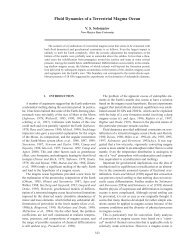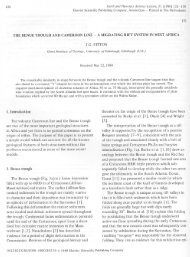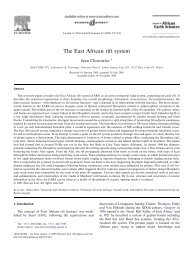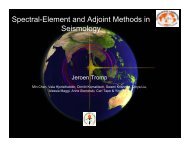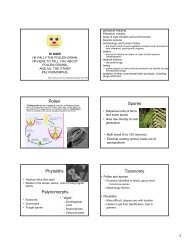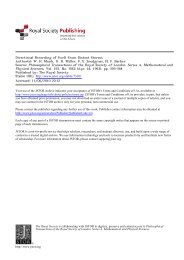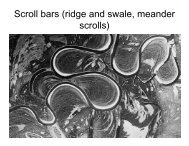High-Resolution Frequency-Wavenumber Spectrum Analysis
High-Resolution Frequency-Wavenumber Spectrum Analysis
High-Resolution Frequency-Wavenumber Spectrum Analysis
- No tags were found...
You also want an ePaper? Increase the reach of your titles
YUMPU automatically turns print PDFs into web optimized ePapers that Google loves.
‘ OClBl1418 PROCEEDINGS OF THE IEEE, AUGUST 1969W COC4BIo 84H6OB4’‘ 081% OBlHZOB4H40 AOHI OBIH4mG60 &l oAOG20 B3H6 0 A0D30~0~5 OAOH3o B3n4OBJH2otozH6OBPH4o B2H2oC281OC3HZ+OC381S[_ 36KMFig. 1 I. A subarray of short-period sensors.0 05-DEw o Ethis change in wavenumber window shape is performed in.an optimum manner, as pointed out previously. As a consequence,it has been shown that the wavenumber resolutionof this method is determined primarily by the amount ofincoherent noise which is present in the array of sensors,and, to a lesser extent, by the natural beam pattern of thearray.The experimental results show a considerable improvementof wavenumber resolution of the high-resolutionmethod relative to the conventional method. In the case ofLPZ seismic noise there was an improvement of about afactor of four, cf. Fig. 3. Thus, the high-resolution methodis extremely useful for the estimation of the frequencywavenumberspectrum when the incoherent noise power isrelatively small compared to the power of the propagatingwaves.The high-resolution method would, of course, be usefulin applications other than seismic arrays. We now mentionbriefly the application of the method to radio astronomy.It is now possible to synchronize the outputs recorded atseveral radio astronomy telescopes [9]. Thus, these telescopescan be considered as sensors in an array, (cf. [9,Fig. 11). If the incoherent noise power in each telescope issufficiently small, i.e., the radio signals from distant starsrecorded by the telescopes should be coherent and. thereshould be relatively little incoherent background noisepower, then the high-resolution method is directly applicablefor the purpose of using this array of telescopes tomap the sources of radio energy.-005-010-015-0.15 -010 -005 0 005 010 015SWAVENUMBER (cycles/krn)for the subarray of shortperiodsensors.Fig. 12. The beam patternventional method of estimation employs a fixed wavenumberwindow, and, as a consequence, the wavenumber resolutionis determined essentially by the natural beam patternof the array of sensors. The high-resolution method of estimationemploys a wavenumber window whose shape, andthus sidelobe structure, changes and is a function of thewavenumber at which an estimate is obtained. In addition,REFERENCES[l] P. E. Green, Jr., R. A. Frosch and C. F. Romney, “Principles of anexperimental large aperture seismic array (LASA),” Proc. IEEE,vol. 53, pp. 1821-1833, December 1965.[2] A. M. Yaglom, An Introduction to the Theory of Stationary RandomFunctions, Englewood Cliffs. N. J.: Prentice Hall, 1962.[3] J. Capon, R. J. Greenfield. and R. J. Kolker, “Multidimensionalmaximum-likelihood processing of a large aperture seismic array,”Proc. IEEE, vol. 55. pp. 192-21 I, February 1967.[4] R. B. Blackman and J. W. Tukey, The Measurement ofpower Spectrafrom the Point of Vie#. of Communication Engineering, New York:Dover Publications, 1959.[5] M. N. Toksijz and R. T. Lacoss. ”Microseisms: mode structure andsources.” Science, vol. 159. pp. 872-873, February 23. 1968.[6] W. L. Pilant and L. Knopoff. “Observations of multiple seismicevents.” Bull. Seismol. Soc. Am., vol. 54, pp 1Ck39, February 1964.[7] J. F. Evernden. “Direction of approach of Rayleigh waves and relatedproblems, Pt. I,” Bull. Seismol. Soc. Am., vol. 43, pp. 335-353,1953.[8] J. F. Evernden. “Direction of approach of Rayleigh waves and relatedproblems. Pt. 11,” Bull. Seismol. Soc. Am.. vol. 44, pp. 159-184,1954.(91 M. H. Cohen. D. L. Jauncey. K. I. Kellermann. and B. G. Clark.“Radio astronomy at one-thousandth second of arc.” Science. vol.162, pp. 88-94, October 4, 1968.Authorized licensed use limited to: WASHINGTON UNIVERSITY LIBRARIES. Downloaded on June 22,2010 at 13:34:08 UTC from IEEE Xplore. Restrictions apply.




